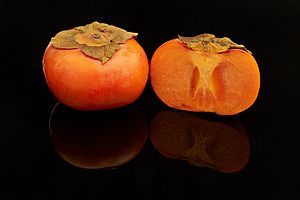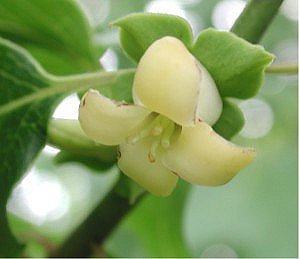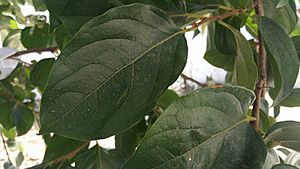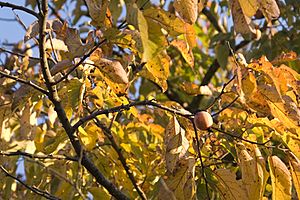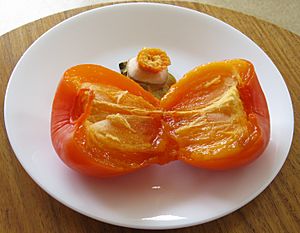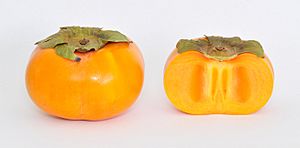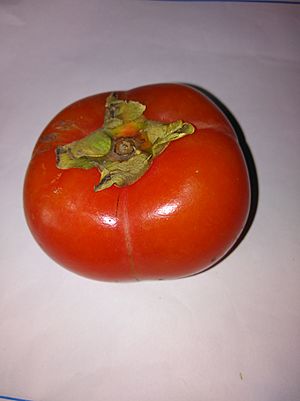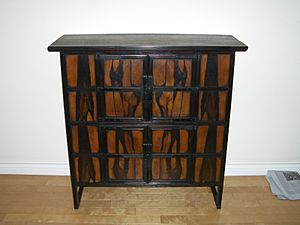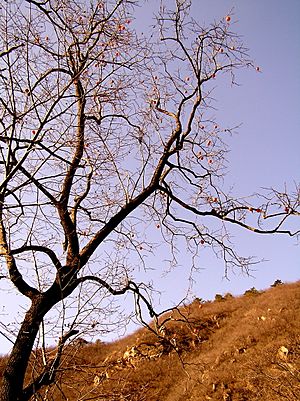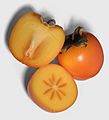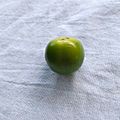Persimmon facts for kids
The persimmon is a tasty fruit that grows on trees in the Diospyros family. The most common type is the Asian or Japanese persimmon, called Diospyros kaki. These trees are related to ebony trees, which are known for their dark, hard wood.
Contents
- What's in a Name?
- About the Persimmon Tree
- How Persimmon Trees Grow (Reproduction)
- Different Types of Persimmons
- Persimmon Fruit: Astringent vs. Non-Astringent
- Cooking with Persimmons
- Nutrients in Persimmons
- Persimmon Wood
- About Persimmon Trees
- Fun Facts and Stories
- In Popular Culture
- Images for kids
- See also
What's in a Name?
The scientific name for the persimmon tree, Diospyros, comes from ancient Greek words. Some people thought it meant "divine fruit" or "God's pear." But actually, the word dio- was just a common part of plant names in old Greek. It referred to the fruit of a different tree, the nettle tree.
The word persimmon comes from a language called Powhatan, spoken by Native Americans in the eastern United States. It means "a dry fruit."
About the Persimmon Tree
The Diospyros kaki tree is the most popular type of persimmon grown around the world. These trees usually grow to be about 4.5 to 18 meters (15 to 60 feet) tall. They often have a round top and stand up straight, but sometimes they can look a bit crooked or like a willow tree.
Their leaves grow in an alternating pattern and are long with hairy stems about 2 cm (1 inch) long. The leaves feel leathery and look shiny on top, while the underside is soft and brownish. Persimmon leaves fall off in autumn, turning beautiful shades of yellow, orange, or red before they drop.
How Persimmon Trees Grow (Reproduction)
Most persimmon trees are either male or female, meaning they have separate trees for male and female flowers. Sometimes, a tree might have both male and female flowers, or even "perfect" flowers that have both parts.
Male flowers are pink and grow in groups of three. Female flowers are creamy-white and grow by themselves. They have a large green cup-like structure called a calyx. "Perfect" flowers are a mix, with both male and female parts.
Persimmon fruit ripens late in the fall and can even stay on the tree into winter. Ripe persimmons can be glossy light yellow-orange to dark red-orange, depending on the type. They vary in size from 1.5 to 9 cm (0.6 to 3.5 inches) across and can be round, acorn-shaped, or pumpkin-shaped.
The inside of the fruit can be yellow, orange, or dark brown. When fully ripe, the fruit is very sweet because it has a lot of glucose (a type of sugar). The green calyx usually stays attached to the fruit after it's picked, but it's easy to remove once the fruit is ripe. Even though they look like fruits, persimmons are actually a type of berry in terms of botany!
Different Types of Persimmons
While many Diospyros trees have fruits that people don't usually eat, some are grown especially for their delicious fruit.
Asian or Japanese Persimmon
The Asian or Japanese persimmon (Diospyros kaki) is the most important type grown for sale. It comes from Japan, China, and Korea. Its fruits are sweet and a little tangy, with a soft or sometimes slightly stringy texture.
This fruit first spread to other parts of Asia, India, and Nepal. Then, in the 1800s, it was brought to California and southern Europe, and to Brazil in the 1890s.
Many different kinds of this persimmon have been developed. Some can be eaten when they are still firm and crunchy, but they taste best when they are allowed to get a little soft after being picked. The 'Hachiya' type from Japan is very popular. Unripe 'Hachiya' persimmons have a lot of tannins, which make them taste bitter. As the fruit ripens, the tannin levels go down. 'Hachiya' persimmons must be completely soft before you eat them. When ripe, they are like a thick, jelly-like pulp inside a thin, waxy skin.
"Sharon fruit" is a special type grown in Israel. It's named after the Sharon Plain where it comes from. These fruits are ripened off the tree using carbon dioxide. Sharon fruit has no core, no seeds, and is very sweet, so you can eat the whole thing!
In the Valencia region of Spain, there's a type of kaki called "Ribera del Xuquer" or "Rojo Brillante" ("bright red").
Date-Plum
The Date-plum (Diospyros lotus) grows in southwest Asia and southeast Europe. The ancient Greeks called it "the fruit of the gods." Its English name probably comes from a Persian word meaning "date-plum," because it tastes a bit like both plums and dates.
American Persimmon
The American persimmon (Diospyros virginiana) is found in the eastern United States. Its fruit is picked in the fall or after the first frost. People eat it fresh, bake it into goods, or make steamed puddings with it. Sometimes, its wood is used like ebony, for example, in musical instruments.
Black Sapote
Black sapote (Diospyros nigra) comes from Mexico. Its fruit has green skin and white flesh that turns dark brown or black when it's ripe. It's also called "chocolate pudding fruit" because of its color and creamy texture.
Velvet-Apple
The Velvet-apple (Diospyros discolor) is native to East Asia, from China to the Philippines. It's bright red when ripe. In China, it's also called shizi.
Indian Persimmon
The Indian persimmon (Diospyros peregrina) is a slow-growing tree from coastal West Bengal. Its fruit is green and turns yellow when ripe. It's quite small and doesn't have a very strong flavor. It's more known for its use in traditional medicine than for eating.
Texas Persimmon
The Texas persimmon (Diospyros texana) grows in central and west Texas in the United States, and parts of Mexico. Its fruits are black on the outside and about 1.5 to 2.5 cm (0.6 to 1 inch) wide. They ripen in August. When they turn dark purple or black, they are sweet and can be eaten fresh or made into pudding or custard.
Persimmon Fruit: Astringent vs. Non-Astringent
There are two main types of persimmon fruit: astringent and non-astringent.
The heart-shaped 'Hachiya' is a common type of astringent persimmon. Astringent persimmons have a lot of soluble tannins, which make them taste very bitter and unpleasant if you eat them before they are completely soft. But when they are fully ripe, they have a wonderfully sweet and delicate flavor.
People remove the bitterness of tannins in different ways. You can ripen them by leaving them in the light for a few days or by wrapping them in paper. This works because it increases the amount of ethylene gas around the fruit. Ethylene is a natural gas that helps fruits ripen. You can also put ripening persimmons in a container with other fruits like apples, pears, or bananas, because these fruits give off a lot of ethylene. Some commercial methods use alcohol or carbon dioxide to change the tannins so they are no longer bitter. Sometimes, exposing the fruit to cold or frost can also help start this process.
Astringent persimmons can also be dried for sale. Some 'Tanenashi' fruits might have a seed or two. If you plant these seeds, they can grow into a taller tree than those grown from grafts.
The non-astringent persimmon is shaped like a squat tomato and is often sold as 'Fuyu'. These persimmons still have tannins, but they are much less bitter before ripening and lose their bitterness faster. You can eat non-astringent persimmons when they are still firm, and they are still good even when they become very soft.
There's also a third, less common type called pollination-variant non-astringent persimmons. If these fruits are fully pollinated, their flesh turns brown inside (called goma in Japan). These can be eaten when they are firm and are highly desired. Examples include 'Tsurunoko' (sold as "chocolate persimmon" for its dark flesh), 'Maru' (sold as "cinnamon persimmon" for its spicy taste), and 'Hyakume' (sold as "brown sugar").
Before they are ripe, persimmons usually have a "chalky" or bitter taste.
Cooking with Persimmons
Persimmons can be eaten fresh, dried, or cooked. When fresh, they are often eaten whole like an apple, or sliced. You can also peel them. If a persimmon is very soft and ripe, you can remove the top leaf and scoop out the flesh with a spoon. You can also break a ripe fruit in half and eat it from the inside. The flesh can be firm or mushy. If it's unripe and firm, it has a crunch like an apple. American persimmons (Diospyros virginiana) and Diospyros digyna are not good to eat until they are fully ripe.
In China, Korea, Japan, and Vietnam, persimmons are often dried outdoors using traditional methods for two to three weeks. Then, they are dried further with heat for several days before being sold as dried fruit. In Japan, dried persimmons are called hoshigaki, in China "shìbǐng", in Korea gotgam, and in Vietnam hồng khô. They are eaten as a snack or dessert and used in other recipes.
In Korea, dried persimmons are used to make a traditional spicy drink called sujeonggwa. The ripe, fermented fruit is also used to make a persimmon vinegar called gamsikcho.
In Taiwan, astringent persimmons are sealed in jars with limewater to remove the bitterness. This process makes them slightly harder, and they are sold as "crisp persimmon" (cuishi) or "water persimmon" (shuishizi).
For centuries, Japanese people have made tea from the dried leaves of "kaki" persimmons, called Kaki-No-Ha Cha. In some parts of Manchuria and Korea, the dried leaves are also used to make tea, known as ghamnip cha in Korea.
In the Midwest of the United States, persimmons are picked and used in many desserts, especially pies. They can also be used in cookies, cakes, puddings, salads, curries, and as a topping for breakfast cereal. Persimmon pudding is a baked dessert that looks like a brownie but has the consistency of pumpkin pie and is almost always topped with whipped cream. Every September, there's an annual persimmon festival in Mitchell, Indiana, which includes a persimmon pudding contest!
You can store persimmons at room temperature (about 20°C or 68°F) where they will continue to ripen. In northern China, unripe persimmons are sometimes frozen outside during winter to help them ripen faster.
Nutrients in Persimmons
Compared to apples, persimmons have more fiber and some dietary minerals. They are a good source of manganese (about 17% of your daily needs) and provitamin A beta-carotene (about 10% of your daily needs) per 100 grams of raw Japanese persimmons.
It's often suggested not to eat persimmons on an empty stomach.
Persimmon Wood
Even though persimmon trees are in the same family as ebony trees, persimmon wood is not used as much for things that need very hard wood. It is hard, but it can crack easily and is a bit difficult to work with. Persimmon wood is used for panels in traditional Korean and Japanese furniture.
In North America, the light-colored, fine-grained wood of D. virginiana is used to make billiard cues and parts for textile machines. It's also used for the shafts of some musical percussion mallets and drumsticks. Persimmon wood was also very popular for making the best quality golf club heads, known as "woods," until metal woods became common in the late 1900s. In fact, the first metal woods from TaylorMade were even called "Pittsburgh Persimmons."
Persimmon wood is still used today, but less often. In recent decades, it has become popular with people who make traditional longbows. It's also used to make a small number of wooden flutes and eating tools like wooden spoons and knives for cornbread (which can cut the bread without scratching the dish).
Like some other trees in the Diospyros family, the older, inner wood (heartwood) of a persimmon tree is black or dark brown. This is a big contrast to the younger wood (sapwood) and outer heartwood, which are pale.
About Persimmon Trees
All types of persimmon trees have stiff, full leaves. However, the female D. virginiana tree's leaves might look less full when it's growing fruit, possibly because it needs more nutrients.
These trees grow quickly and can handle different kinds of weather. Persimmons are very adaptable to many climates. They are also known for being strong against diseases and pests. They are one of the last trees to grow leaves in the spring and don't flower until well after the leaves have formed. This helps them avoid losing blossoms to late frosts. The fruit stays on the branches long into the winter. Because they grow fast and spread from their roots, they are great for helping nature areas recover. A persimmon tree will be old enough to produce fruit in about 7–8 years. They can also handle flooded riverbanks well and are known for their ability to hold water.
Fun Facts and Stories
- In Ozark folklore, people say you can predict how harsh the upcoming winter will be by slicing a persimmon seed and looking at the shape inside it.
- In Korean folklore, the dried persimmon (gotgam) is said to scare away tigers!
In Popular Culture
- Persimmons are the favorite food of the main character in the movie Okja.
Images for kids
-
Persimmon fruit tree in Wanju County, South Korea.
-
Diospyros texana (Texas persimmon)
See also
 In Spanish: Caqui para niños
In Spanish: Caqui para niños


